Financial Accounting and Control Concepts
VerifiedAdded on 2020/03/16
|8
|1530
|41
AI Summary
This assignment delves into key concepts within financial accounting. It examines various capital budgeting methods, including payback period calculations, highlighting their advantages and disadvantages. Furthermore, it explores the multifaceted role of a controller within an organization, encompassing tasks like financial statement preparation, tax management, and cost accounting. The assignment emphasizes the importance of understanding these concepts for effective decision-making in finance and business management.
Contribute Materials
Your contribution can guide someone’s learning journey. Share your
documents today.
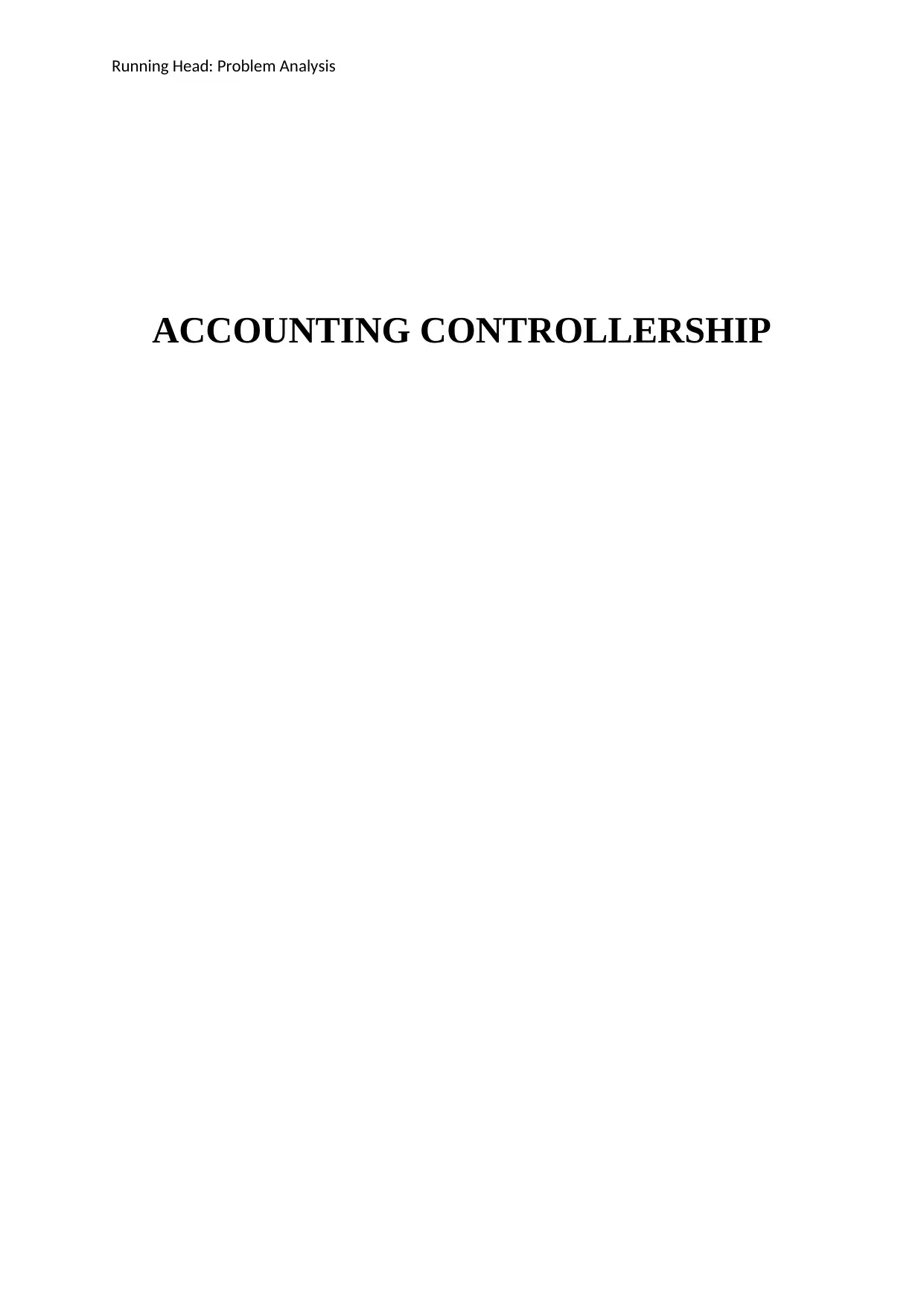
Running Head: Problem Analysis
ACCOUNTING CONTROLLERSHIP
ACCOUNTING CONTROLLERSHIP
Secure Best Marks with AI Grader
Need help grading? Try our AI Grader for instant feedback on your assignments.
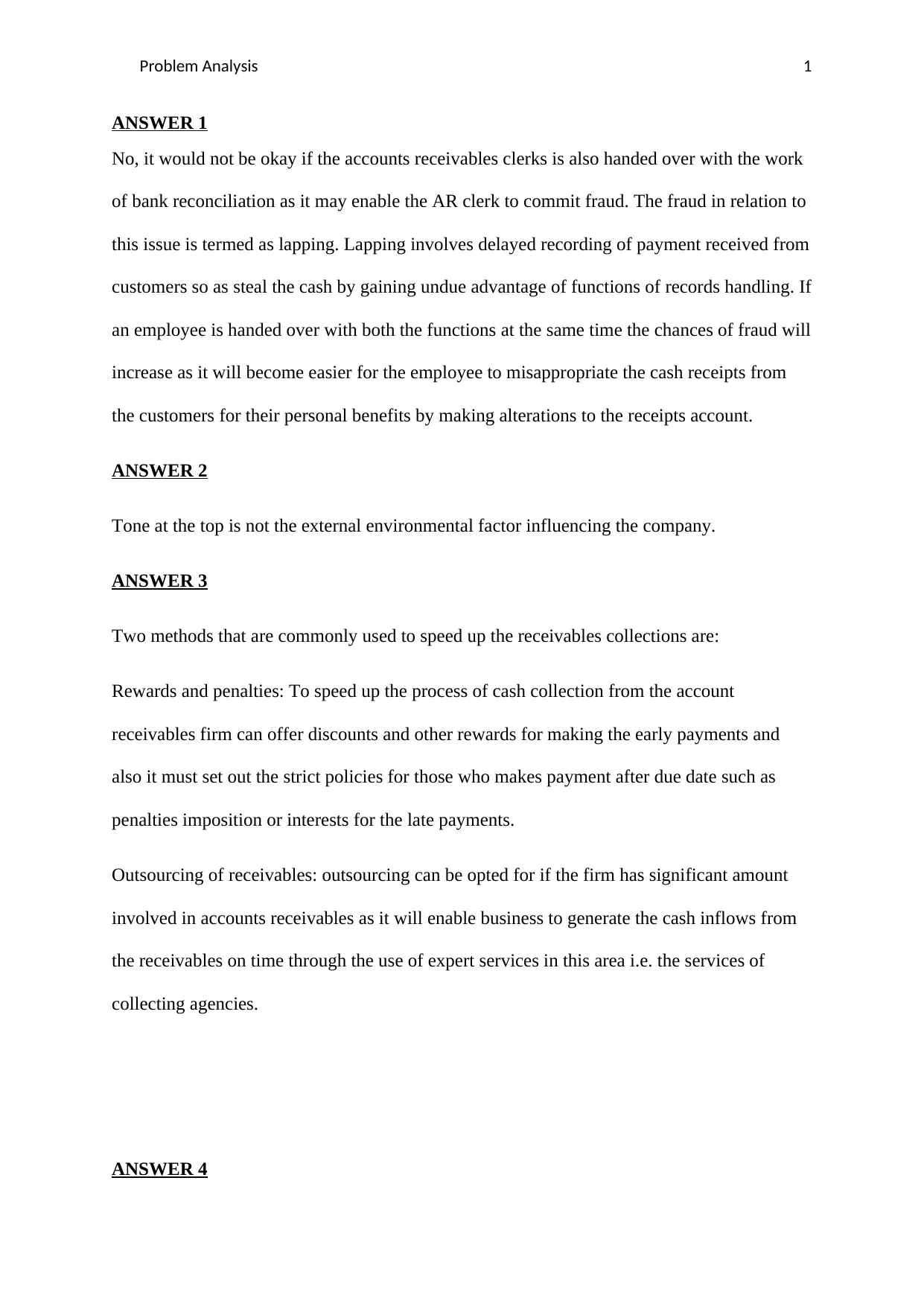
Problem Analysis 1
ANSWER 1
No, it would not be okay if the accounts receivables clerks is also handed over with the work
of bank reconciliation as it may enable the AR clerk to commit fraud. The fraud in relation to
this issue is termed as lapping. Lapping involves delayed recording of payment received from
customers so as steal the cash by gaining undue advantage of functions of records handling. If
an employee is handed over with both the functions at the same time the chances of fraud will
increase as it will become easier for the employee to misappropriate the cash receipts from
the customers for their personal benefits by making alterations to the receipts account.
ANSWER 2
Tone at the top is not the external environmental factor influencing the company.
ANSWER 3
Two methods that are commonly used to speed up the receivables collections are:
Rewards and penalties: To speed up the process of cash collection from the account
receivables firm can offer discounts and other rewards for making the early payments and
also it must set out the strict policies for those who makes payment after due date such as
penalties imposition or interests for the late payments.
Outsourcing of receivables: outsourcing can be opted for if the firm has significant amount
involved in accounts receivables as it will enable business to generate the cash inflows from
the receivables on time through the use of expert services in this area i.e. the services of
collecting agencies.
ANSWER 4
ANSWER 1
No, it would not be okay if the accounts receivables clerks is also handed over with the work
of bank reconciliation as it may enable the AR clerk to commit fraud. The fraud in relation to
this issue is termed as lapping. Lapping involves delayed recording of payment received from
customers so as steal the cash by gaining undue advantage of functions of records handling. If
an employee is handed over with both the functions at the same time the chances of fraud will
increase as it will become easier for the employee to misappropriate the cash receipts from
the customers for their personal benefits by making alterations to the receipts account.
ANSWER 2
Tone at the top is not the external environmental factor influencing the company.
ANSWER 3
Two methods that are commonly used to speed up the receivables collections are:
Rewards and penalties: To speed up the process of cash collection from the account
receivables firm can offer discounts and other rewards for making the early payments and
also it must set out the strict policies for those who makes payment after due date such as
penalties imposition or interests for the late payments.
Outsourcing of receivables: outsourcing can be opted for if the firm has significant amount
involved in accounts receivables as it will enable business to generate the cash inflows from
the receivables on time through the use of expert services in this area i.e. the services of
collecting agencies.
ANSWER 4
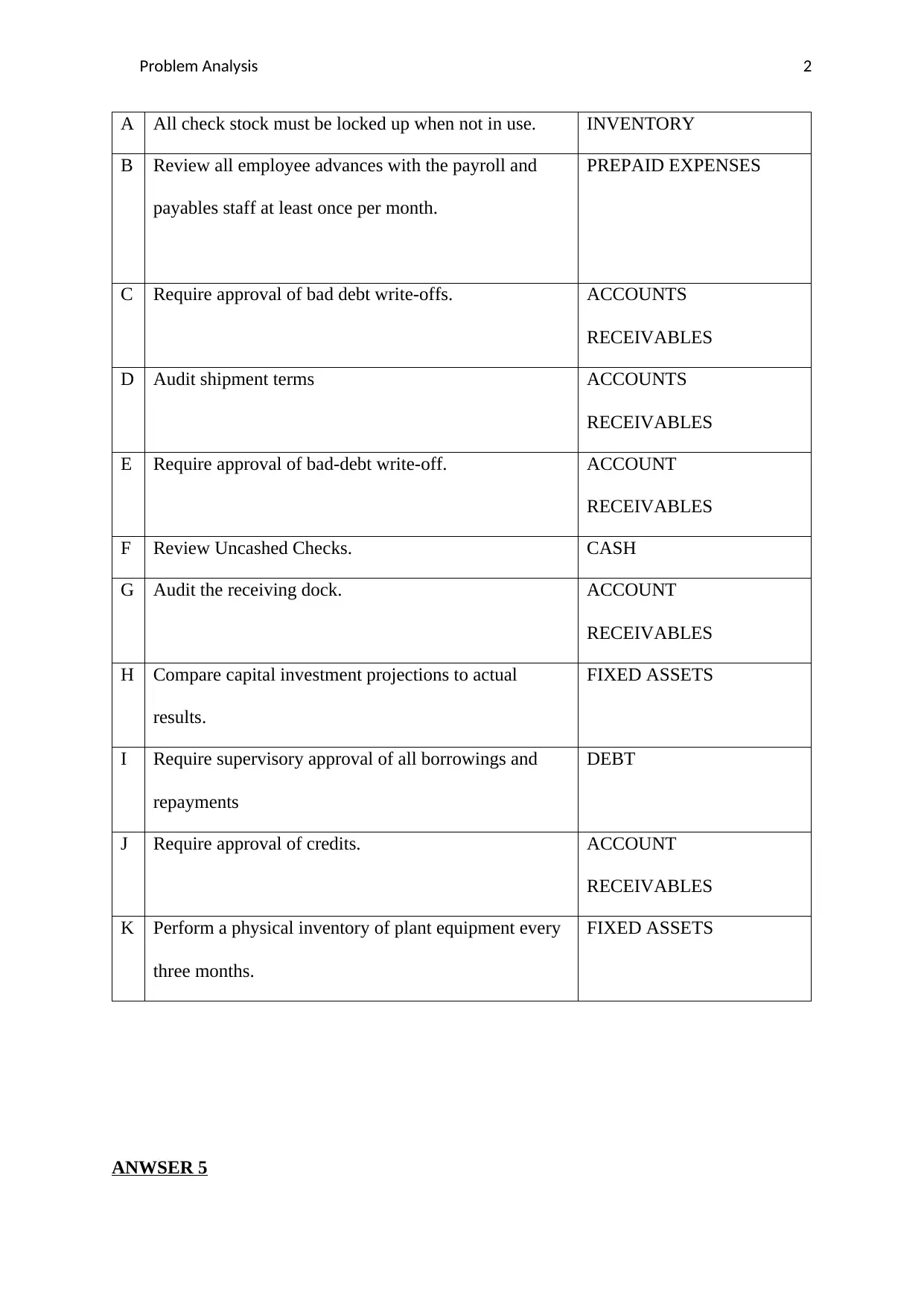
Problem Analysis 2
A All check stock must be locked up when not in use. INVENTORY
B Review all employee advances with the payroll and
payables staff at least once per month.
PREPAID EXPENSES
C Require approval of bad debt write-offs. ACCOUNTS
RECEIVABLES
D Audit shipment terms ACCOUNTS
RECEIVABLES
E Require approval of bad-debt write-off. ACCOUNT
RECEIVABLES
F Review Uncashed Checks. CASH
G Audit the receiving dock. ACCOUNT
RECEIVABLES
H Compare capital investment projections to actual
results.
FIXED ASSETS
I Require supervisory approval of all borrowings and
repayments
DEBT
J Require approval of credits. ACCOUNT
RECEIVABLES
K Perform a physical inventory of plant equipment every
three months.
FIXED ASSETS
ANWSER 5
A All check stock must be locked up when not in use. INVENTORY
B Review all employee advances with the payroll and
payables staff at least once per month.
PREPAID EXPENSES
C Require approval of bad debt write-offs. ACCOUNTS
RECEIVABLES
D Audit shipment terms ACCOUNTS
RECEIVABLES
E Require approval of bad-debt write-off. ACCOUNT
RECEIVABLES
F Review Uncashed Checks. CASH
G Audit the receiving dock. ACCOUNT
RECEIVABLES
H Compare capital investment projections to actual
results.
FIXED ASSETS
I Require supervisory approval of all borrowings and
repayments
DEBT
J Require approval of credits. ACCOUNT
RECEIVABLES
K Perform a physical inventory of plant equipment every
three months.
FIXED ASSETS
ANWSER 5
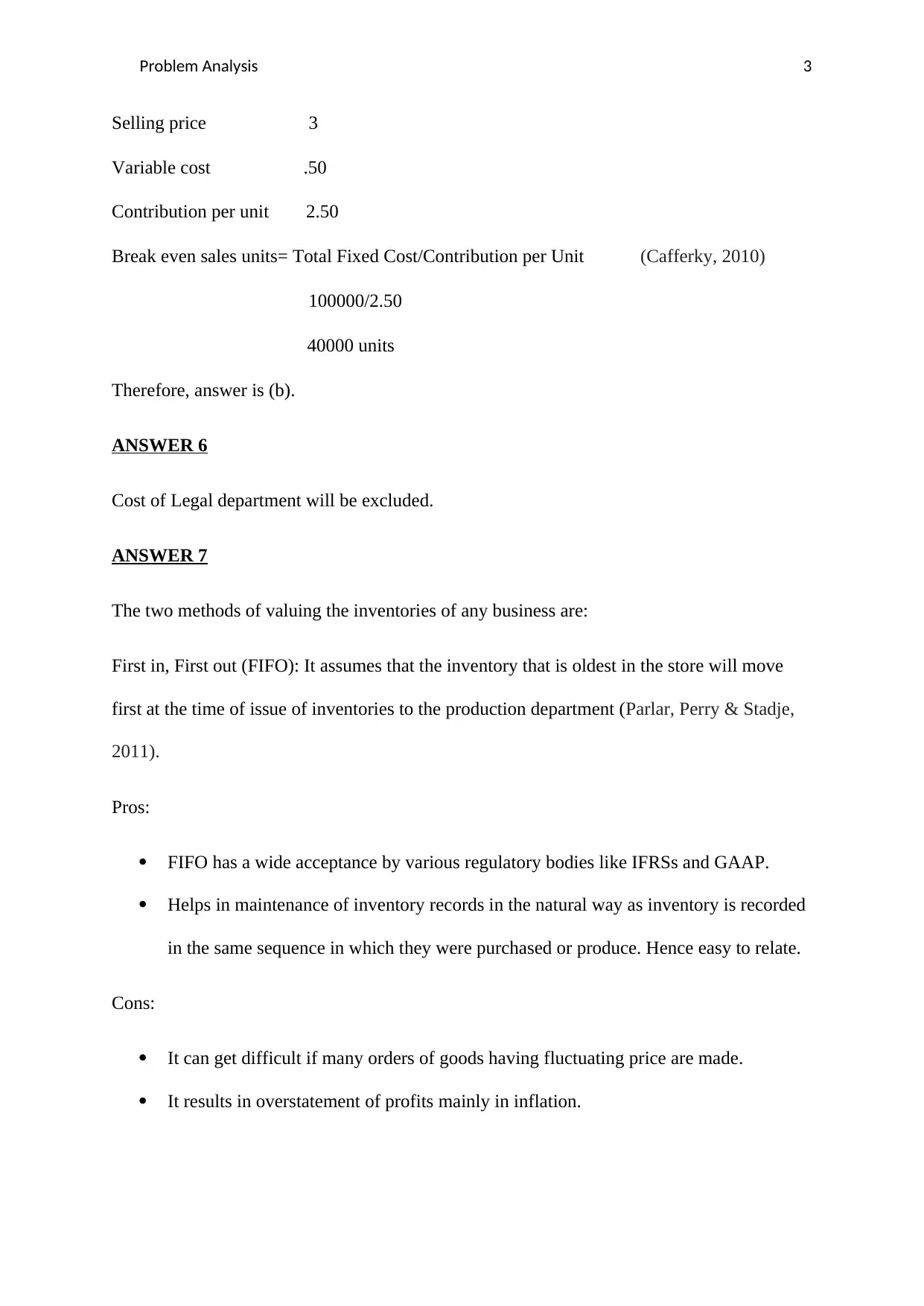
Problem Analysis 3
Selling price 3
Variable cost .50
Contribution per unit 2.50
Break even sales units= Total Fixed Cost/Contribution per Unit (Cafferky, 2010)
100000/2.50
40000 units
Therefore, answer is (b).
ANSWER 6
Cost of Legal department will be excluded.
ANSWER 7
The two methods of valuing the inventories of any business are:
First in, First out (FIFO): It assumes that the inventory that is oldest in the store will move
first at the time of issue of inventories to the production department (Parlar, Perry & Stadje,
2011).
Pros:
FIFO has a wide acceptance by various regulatory bodies like IFRSs and GAAP.
Helps in maintenance of inventory records in the natural way as inventory is recorded
in the same sequence in which they were purchased or produce. Hence easy to relate.
Cons:
It can get difficult if many orders of goods having fluctuating price are made.
It results in overstatement of profits mainly in inflation.
Selling price 3
Variable cost .50
Contribution per unit 2.50
Break even sales units= Total Fixed Cost/Contribution per Unit (Cafferky, 2010)
100000/2.50
40000 units
Therefore, answer is (b).
ANSWER 6
Cost of Legal department will be excluded.
ANSWER 7
The two methods of valuing the inventories of any business are:
First in, First out (FIFO): It assumes that the inventory that is oldest in the store will move
first at the time of issue of inventories to the production department (Parlar, Perry & Stadje,
2011).
Pros:
FIFO has a wide acceptance by various regulatory bodies like IFRSs and GAAP.
Helps in maintenance of inventory records in the natural way as inventory is recorded
in the same sequence in which they were purchased or produce. Hence easy to relate.
Cons:
It can get difficult if many orders of goods having fluctuating price are made.
It results in overstatement of profits mainly in inflation.
Secure Best Marks with AI Grader
Need help grading? Try our AI Grader for instant feedback on your assignments.

Problem Analysis 4
Last in, First out (LIFO): It assumes that the latest inventory that has been entered to the
warehouses will move first at the time of issuing inventories to the production units
(Jesswein, 2010).
Pros:
LIFO helps in avoiding inventory deterioration as the old stock is quickly moved to
production.
LIFO eliminates or minimises the risk of write downs to market and hence the net
profit does not get affected by the decline in future prices of inventory.
Cons:
Firm using LIFO can easily manipulate its earnings by making change to the purchase
pattern at year ending.
In LIFO, balance sheet carries the oldest cost of inventory which sometimes
underestimates the firm’s profit.
ANSWER 8
Receivable float: It is the time gap between the day when the customers or the debtors of the
firm had made the payment and the day when funds are actually available for the deployment,
in the bank account of firm (Kuen-Chor, 2014). There can be several reasons of this time gap.
For example,
Delayed presentation of cheques before the bank for the collection.
The time required by the bank to make cheque clearance.
Payable float: It can be defined as the time gap between the day on which check is being
written and the day when the amount was deducted from the bank account of company.
Last in, First out (LIFO): It assumes that the latest inventory that has been entered to the
warehouses will move first at the time of issuing inventories to the production units
(Jesswein, 2010).
Pros:
LIFO helps in avoiding inventory deterioration as the old stock is quickly moved to
production.
LIFO eliminates or minimises the risk of write downs to market and hence the net
profit does not get affected by the decline in future prices of inventory.
Cons:
Firm using LIFO can easily manipulate its earnings by making change to the purchase
pattern at year ending.
In LIFO, balance sheet carries the oldest cost of inventory which sometimes
underestimates the firm’s profit.
ANSWER 8
Receivable float: It is the time gap between the day when the customers or the debtors of the
firm had made the payment and the day when funds are actually available for the deployment,
in the bank account of firm (Kuen-Chor, 2014). There can be several reasons of this time gap.
For example,
Delayed presentation of cheques before the bank for the collection.
The time required by the bank to make cheque clearance.
Payable float: It can be defined as the time gap between the day on which check is being
written and the day when the amount was deducted from the bank account of company.
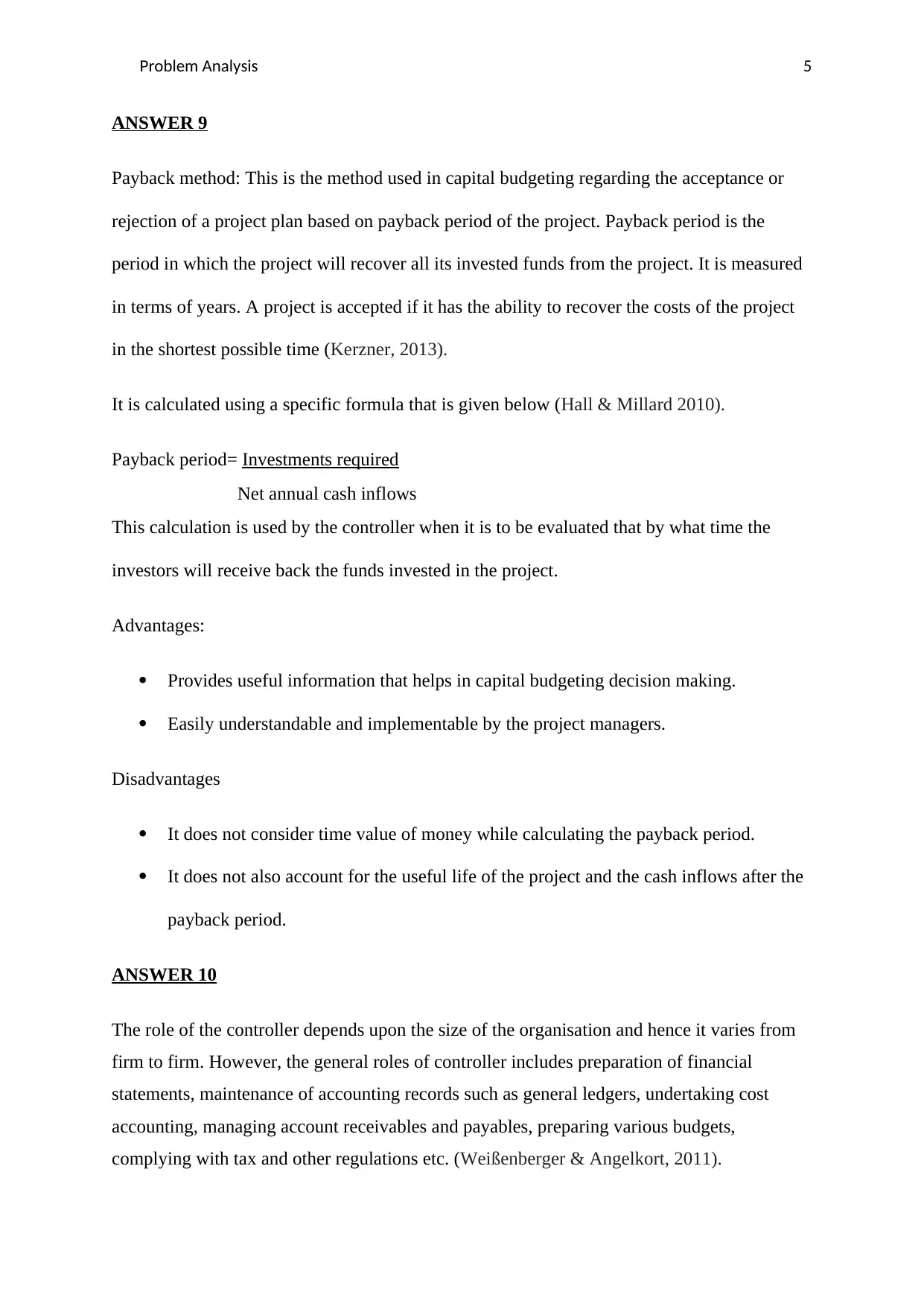
Problem Analysis 5
ANSWER 9
Payback method: This is the method used in capital budgeting regarding the acceptance or
rejection of a project plan based on payback period of the project. Payback period is the
period in which the project will recover all its invested funds from the project. It is measured
in terms of years. A project is accepted if it has the ability to recover the costs of the project
in the shortest possible time (Kerzner, 2013).
It is calculated using a specific formula that is given below (Hall & Millard 2010).
Payback period= Investments required
Net annual cash inflows
This calculation is used by the controller when it is to be evaluated that by what time the
investors will receive back the funds invested in the project.
Advantages:
Provides useful information that helps in capital budgeting decision making.
Easily understandable and implementable by the project managers.
Disadvantages
It does not consider time value of money while calculating the payback period.
It does not also account for the useful life of the project and the cash inflows after the
payback period.
ANSWER 10
The role of the controller depends upon the size of the organisation and hence it varies from
firm to firm. However, the general roles of controller includes preparation of financial
statements, maintenance of accounting records such as general ledgers, undertaking cost
accounting, managing account receivables and payables, preparing various budgets,
complying with tax and other regulations etc. (Weißenberger & Angelkort, 2011).
ANSWER 9
Payback method: This is the method used in capital budgeting regarding the acceptance or
rejection of a project plan based on payback period of the project. Payback period is the
period in which the project will recover all its invested funds from the project. It is measured
in terms of years. A project is accepted if it has the ability to recover the costs of the project
in the shortest possible time (Kerzner, 2013).
It is calculated using a specific formula that is given below (Hall & Millard 2010).
Payback period= Investments required
Net annual cash inflows
This calculation is used by the controller when it is to be evaluated that by what time the
investors will receive back the funds invested in the project.
Advantages:
Provides useful information that helps in capital budgeting decision making.
Easily understandable and implementable by the project managers.
Disadvantages
It does not consider time value of money while calculating the payback period.
It does not also account for the useful life of the project and the cash inflows after the
payback period.
ANSWER 10
The role of the controller depends upon the size of the organisation and hence it varies from
firm to firm. However, the general roles of controller includes preparation of financial
statements, maintenance of accounting records such as general ledgers, undertaking cost
accounting, managing account receivables and payables, preparing various budgets,
complying with tax and other regulations etc. (Weißenberger & Angelkort, 2011).
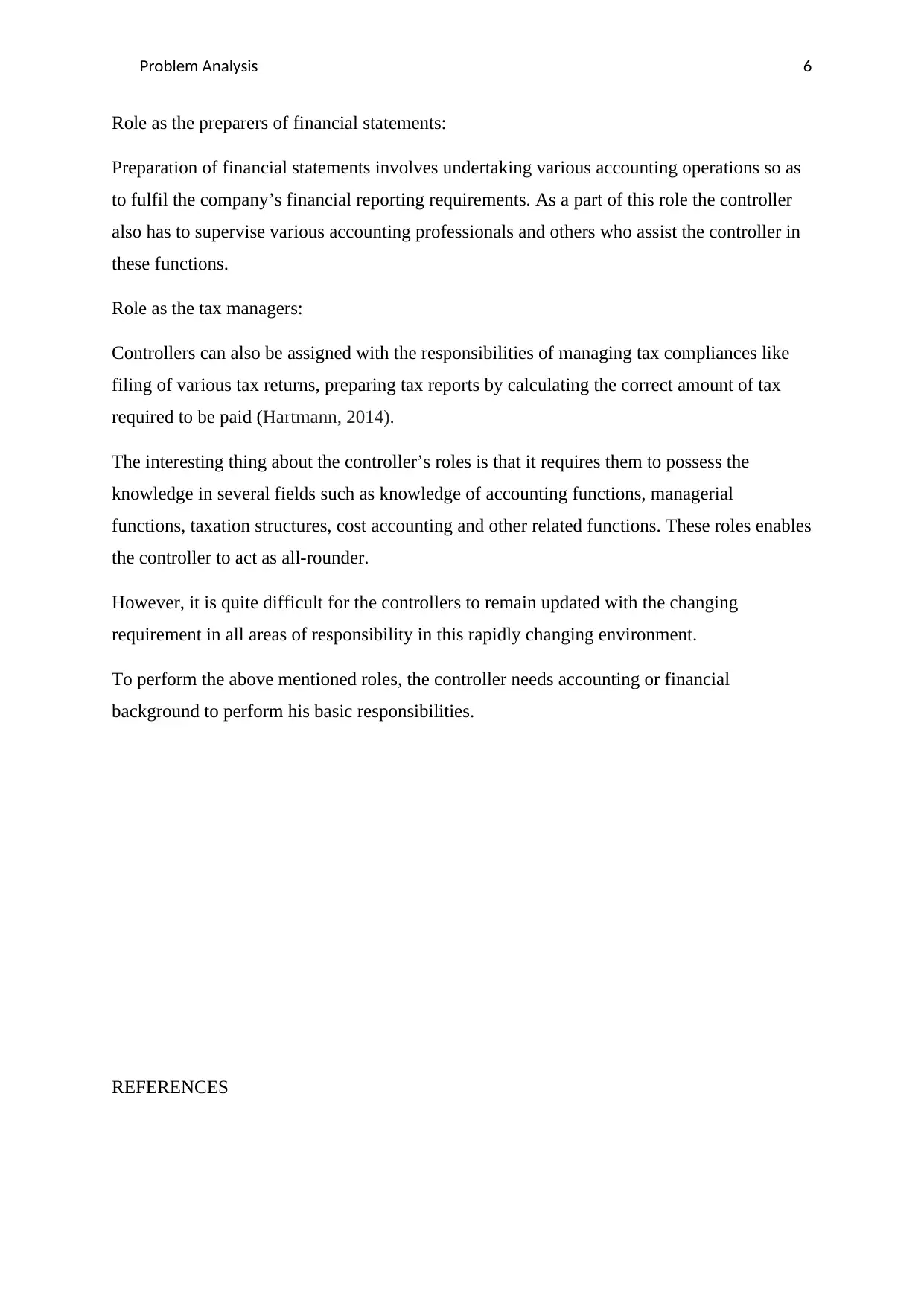
Problem Analysis 6
Role as the preparers of financial statements:
Preparation of financial statements involves undertaking various accounting operations so as
to fulfil the company’s financial reporting requirements. As a part of this role the controller
also has to supervise various accounting professionals and others who assist the controller in
these functions.
Role as the tax managers:
Controllers can also be assigned with the responsibilities of managing tax compliances like
filing of various tax returns, preparing tax reports by calculating the correct amount of tax
required to be paid (Hartmann, 2014).
The interesting thing about the controller’s roles is that it requires them to possess the
knowledge in several fields such as knowledge of accounting functions, managerial
functions, taxation structures, cost accounting and other related functions. These roles enables
the controller to act as all-rounder.
However, it is quite difficult for the controllers to remain updated with the changing
requirement in all areas of responsibility in this rapidly changing environment.
To perform the above mentioned roles, the controller needs accounting or financial
background to perform his basic responsibilities.
REFERENCES
Role as the preparers of financial statements:
Preparation of financial statements involves undertaking various accounting operations so as
to fulfil the company’s financial reporting requirements. As a part of this role the controller
also has to supervise various accounting professionals and others who assist the controller in
these functions.
Role as the tax managers:
Controllers can also be assigned with the responsibilities of managing tax compliances like
filing of various tax returns, preparing tax reports by calculating the correct amount of tax
required to be paid (Hartmann, 2014).
The interesting thing about the controller’s roles is that it requires them to possess the
knowledge in several fields such as knowledge of accounting functions, managerial
functions, taxation structures, cost accounting and other related functions. These roles enables
the controller to act as all-rounder.
However, it is quite difficult for the controllers to remain updated with the changing
requirement in all areas of responsibility in this rapidly changing environment.
To perform the above mentioned roles, the controller needs accounting or financial
background to perform his basic responsibilities.
REFERENCES
Paraphrase This Document
Need a fresh take? Get an instant paraphrase of this document with our AI Paraphraser
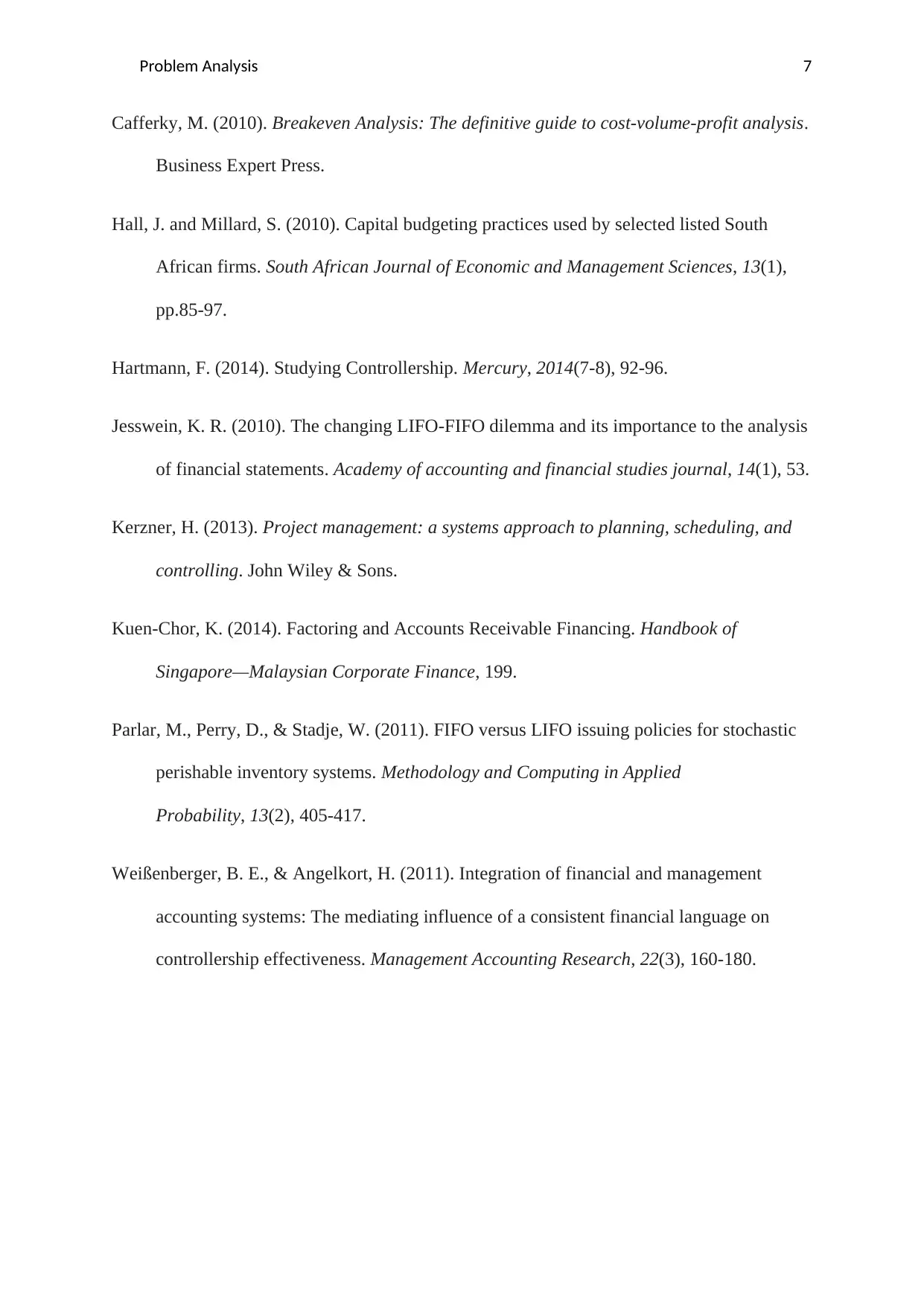
Problem Analysis 7
Cafferky, M. (2010). Breakeven Analysis: The definitive guide to cost-volume-profit analysis.
Business Expert Press.
Hall, J. and Millard, S. (2010). Capital budgeting practices used by selected listed South
African firms. South African Journal of Economic and Management Sciences, 13(1),
pp.85-97.
Hartmann, F. (2014). Studying Controllership. Mercury, 2014(7-8), 92-96.
Jesswein, K. R. (2010). The changing LIFO-FIFO dilemma and its importance to the analysis
of financial statements. Academy of accounting and financial studies journal, 14(1), 53.
Kerzner, H. (2013). Project management: a systems approach to planning, scheduling, and
controlling. John Wiley & Sons.
Kuen-Chor, K. (2014). Factoring and Accounts Receivable Financing. Handbook of
Singapore—Malaysian Corporate Finance, 199.
Parlar, M., Perry, D., & Stadje, W. (2011). FIFO versus LIFO issuing policies for stochastic
perishable inventory systems. Methodology and Computing in Applied
Probability, 13(2), 405-417.
Weißenberger, B. E., & Angelkort, H. (2011). Integration of financial and management
accounting systems: The mediating influence of a consistent financial language on
controllership effectiveness. Management Accounting Research, 22(3), 160-180.
Cafferky, M. (2010). Breakeven Analysis: The definitive guide to cost-volume-profit analysis.
Business Expert Press.
Hall, J. and Millard, S. (2010). Capital budgeting practices used by selected listed South
African firms. South African Journal of Economic and Management Sciences, 13(1),
pp.85-97.
Hartmann, F. (2014). Studying Controllership. Mercury, 2014(7-8), 92-96.
Jesswein, K. R. (2010). The changing LIFO-FIFO dilemma and its importance to the analysis
of financial statements. Academy of accounting and financial studies journal, 14(1), 53.
Kerzner, H. (2013). Project management: a systems approach to planning, scheduling, and
controlling. John Wiley & Sons.
Kuen-Chor, K. (2014). Factoring and Accounts Receivable Financing. Handbook of
Singapore—Malaysian Corporate Finance, 199.
Parlar, M., Perry, D., & Stadje, W. (2011). FIFO versus LIFO issuing policies for stochastic
perishable inventory systems. Methodology and Computing in Applied
Probability, 13(2), 405-417.
Weißenberger, B. E., & Angelkort, H. (2011). Integration of financial and management
accounting systems: The mediating influence of a consistent financial language on
controllership effectiveness. Management Accounting Research, 22(3), 160-180.
1 out of 8
Related Documents
Your All-in-One AI-Powered Toolkit for Academic Success.
+13062052269
info@desklib.com
Available 24*7 on WhatsApp / Email
![[object Object]](/_next/static/media/star-bottom.7253800d.svg)
Unlock your academic potential
© 2024 | Zucol Services PVT LTD | All rights reserved.
